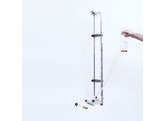Quincke’s resonance tube is used for demonstrating interference effects in standing sound waves. The equipment set consists of a resonance tube with a millimetre scale which is partially filled with water and is connected to an expansion vessel with a tube. The column of air above the water is excited to oscillate by using a tuning fork (or optionally a loudspeaker). By raising the expansion tank, the level of water inside the tube can be raised as well, which therefore reduces the height of the air column. The sound wave emitted by a sound source above the one open end of the tube is superimposed on the wave reflected from the surface of the water which results in constructive or destructive interference. Audible resonances occur when the length of the oscillating column of air is an odd integer multiple of a quarter wavelength of the sound.
Height of resonance tube: 1 m
Diameter of resonance tube: 3 cm
Scale: 98 cm
Divisions: 1 mm
Height of expansion vessel: 24 cm
Diameter of expansion vessel: 7 cm
Weight (without accessories and stands): 3.3 kg approx.
Contents:
1 Resonance tube with scale
1 Expansion vessel
1 Silicone tube
2 Horizontal clamps
1 Standard tuning fork, a1 = 440 Hz
1 Beater
Experiment Topics:
· Resonances in an oscillating column of air
· Standing sound waves
· Determination of wavelengths of sound waves in air
· Determination of speed of sound in air
Height of resonance tube: 1 m
Diameter of resonance tube: 3 cm
Scale: 98 cm
Divisions: 1 mm
Height of expansion vessel: 24 cm
Diameter of expansion vessel: 7 cm
Weight (without accessories and stands): 3.3 kg approx.
Contents:
1 Resonance tube with scale
1 Expansion vessel
1 Silicone tube
2 Horizontal clamps
1 Standard tuning fork, a1 = 440 Hz
1 Beater
Experiment Topics:
· Resonances in an oscillating column of air
· Standing sound waves
· Determination of wavelengths of sound waves in air
· Determination of speed of sound in air
Eigenschappen
- 1018475/3B
- U8557190

